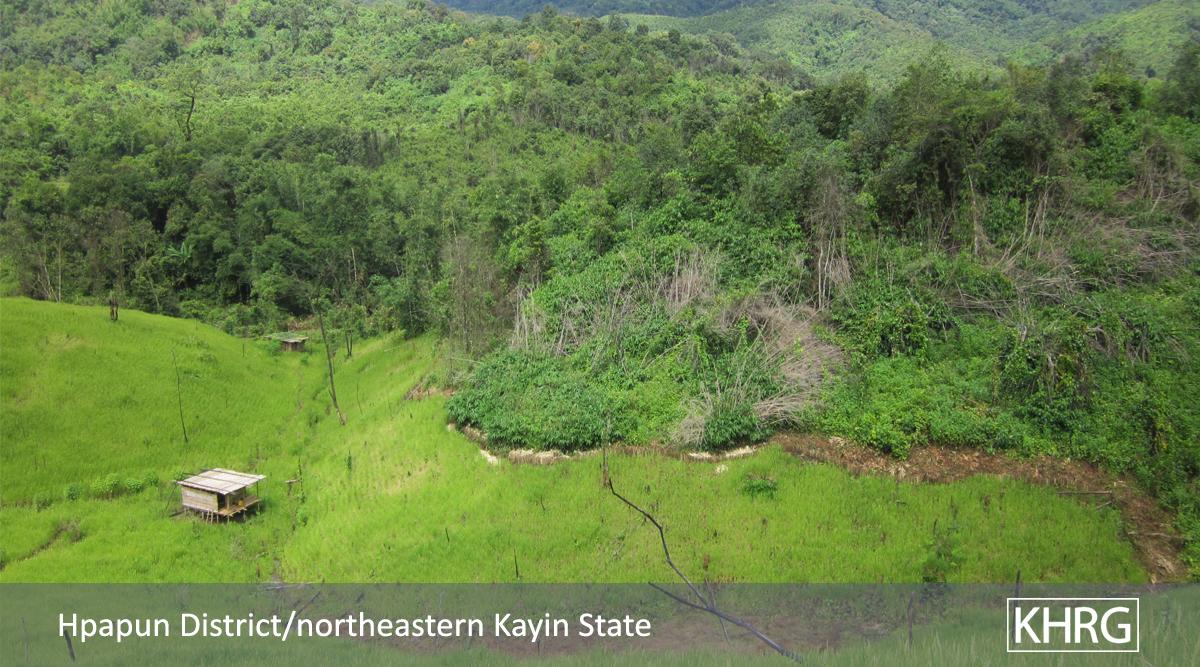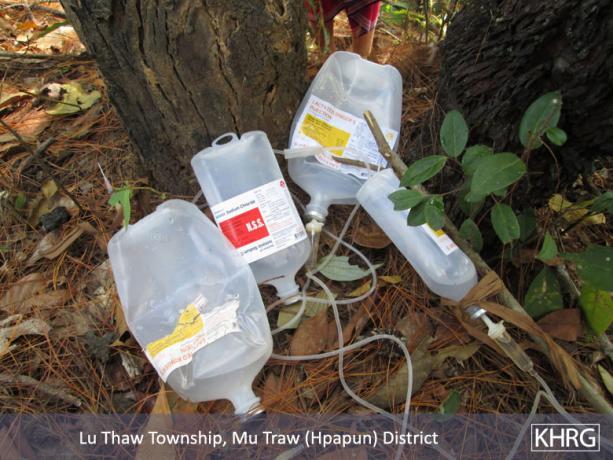This Incident Report describes the death of a home guard on January 24th 2014 after he stepped on a Tatmadaw landmine whilst hunting for birds in the forest. Home guards are villagers who provide security for communities of civilians in hiding. Widespread displacement occurred in Lu Thaw Township during Tatmadaw offensives in 1997 and between 2005 and 2008. Since then, many of those displaced have lived in make-shift, temporary housing in the jungle and mountainous areas with inadequate health and education facilities and without access to land on which to grow food for daily consumption. Villagers living in these areas have demanded that local Tatmadaw bases be closed so they can return to their homes, and have highlighted a range of risks associated with living in internal displacement sites, including exposure to landmines.
Incident Report | Lu Thaw Township, Hpapun District (January 2014)
The following Incident Report was written by a community member who has been trained by KHRG to monitor human rights abuses. It is presented below translated exactly as originally written, save for minor edits for clarity and security.[1] This report was received in March 2014 along with other information from Hpapun District, including five other incident reports, four interviews, one situation update, 86 photographs and three video clips.[2]
Part 1 – Incident Details
|
Type of Incident |
A home guard[3] was killed by a Tatmadaw landmine
|
|
Date of Incident(s) |
January 24th 2014 |
|
Incident Location (Village, Township and District) |
A--- village, Ler Muh Plaw village tract, Lu Thaw Township, Mu Traw [Hpapun] District |
|
Victim Information |
|
|
Name |
Saw Shway Thay |
|
Age |
52 |
|
Sex |
Male |
|
Nationality |
Karen |
|
Family |
Married |
|
Occupation |
Hill farming |
|
Religion |
Animist |
|
Position |
Home guard |
|
Village |
A--- |
|
Perpetrator Information |
||||
|
Name(s) |
Rank |
Unit |
Base |
Commander’s Name |
|
N/A |
N/A |
N/A |
Htaw Muh Pleh Meh [Tatmadaw army camp] |
N/A |
Part 2 - Information Quality
|
1. Explain in detail how you collected this information. |
|
On January 31st 2014, I [KHRG community member] met with a home guard called Saw C---, 26 years old, who lived in A--- [village], [but was] displaced [from there and now lives] in E--- [internal displacement site]. He is from Ler Muh Plaw village tract. |
|
2. Explain how the source verified this information. |
|
Saw C--- is a home guard and he was travelling with Saw Shway Thay when Saw Shway Thay was killed by a Tatmadaw landmine on T’Ray Ler hill, nearby Htaw Muh Pleh Meh army camp. |
Part 3 – Incident Details
|
Describe the Incident(s) in complete detail. For each incident, be sure to include 1) when the incident happened, 2) where it happened, 3) what happened, 4) how it happened, 5) who was involved, and 6) why it happened. Also describe any villager response(s) to the incident, the aftermath and the current living situation of the victims. Please use the space prepared below, and create an attachment if needed. |
|
On January 31st 2014, I [KHRG community member] met with a home guard named Saw C--- and asked him about a home guard who was killed [by a landmine]. Saw C--- said that he went back [with Saw Shway Thay] and visited his old village, A---, and made a trap to capture birds. Both of them [Saw C--- and Saw Shway Thay] went back with guns [home made muskets] to check the trap, which is close to a Tatmadaw area. [He added that,] “At that time, my friend Shway Thay was hit by [stepped on a] landmine, and I was worried that the Tatmadaw might come, so I put him on my back and carried both his gun and mine. I ran until [I reached] a little distance [from where the landmine exploded] and I put him down. My whole body was covered with his blood. When we arrived at a place, which is one hour’s walk away from where the landmine exploded, I met a woman and I asked her to look after the patient [Saw Shway Thay]. Then, I came back [to E--- internal displacement site] to pick up the medic and people to carry the patient. He was hit by the landmine on T’Ray Ler hill on January 24th 2014 at 10:40 am. His neck was blown open and he lost most of his right ankle. He had been serving as a home guard for seven years and his wife’s name is Naw K---, [she is] 50 years old. They lived in A--- village, Ler Muh Plaw village tract [before they were displaced] and they don’t have any children. His wife was left alone.” According to Saw C---, the person who was hit by landmine is called Saw Shway Thay; [he was] 52 years old and he passed away an hour after he was hit by the landmine. |
Part 4 - Permission for Using the Details
|
Did the victim(s) provide permission to use this information? Explain how that permission was provided. |
|
The victim [the person who reported this information, Saw C---] gave us permission to use this information so that the leaders will know [about the incident] and people from foreign counties will also know about the situation of the people in our area. |
Footnotes:
[1] KHRG trains community members in eastern Burma to document individual incidents of abuse using a standardised reporting format; conduct interviews with other villagers; and write general updates on the situation in areas with which they are familiar. When writing incident reports, community members are encouraged to document incidents of abuse that they consider to be important, by verifying information from multiple sources, assessing for potential biases and comparing to local trends.
[2] In order to increase the transparency of KHRG methodology and more directly communicate the experiences and perspectives of villagers in eastern Burma, KHRG aims to make all field information received available on the KHRG website once it has been processed and translated, subject only to security considerations. For additional reports categorized by Type, Issue, Location and Year, please see the Related Readings component following each report on KHRG’s Website.
[3] 'Home guard' or gher der groups have been organised locally in parts of northern Karen State to address Tatmadaw operations targeting civilians and the resulting acute food insecurity. Villagers interviewed by KHRG have reported that gher der were established with the objective of providing security for communities of civilians in hiding, particularly when those communities engage in food production or procurement activities, and when other modes of protection are unavailable. For more on the gher der see: “Self-protection under strain: Targeting of civilians and local responses in northern Karen State,” KHRG, August 2010.









